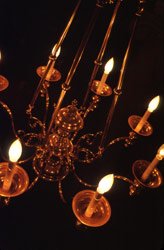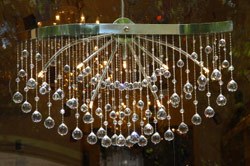
You may think of the word "chandelier" and the word "crystal" in the same breath. This would be a mistake, and could keep you from experiencing the joys of having a chandelier in your home.
Because they have several small bulbs, chandeliers shed a light that can be quite soft and flattering. While they do add a note of elegance to a room, they can also be quite modern, even though they date to the Middle Ages, when they were first used. The first chandeliers were usually in the shape of a cross, and of course the light didn't come from cute little bulbs but from candles.
We don't advise you go back to the original look for your home, largely because this could mean you spend all your hostessing skills making sure your dinner guests don't catch on fire rather than seeing to the potato-leek soup.
In the 15th century, the chandelier became more decorative, eventually developing ornate designs with curved arms and many candles at different levels. Soon, they were made not only of wood but also of cast metal — seems like a good idea if you're going to have burning candles, to have them on an inflammable material.

In the 18th century, glassmaking techniques created lead crystal, which is lead glass that has been cut with facets. These facets, of course, catch the light beautifully, and so the crystal chandelier was born and became the standard for chandeliers.
As gas lighting, and then electric lighting, developed, chandeliers were modified to accommodate the new technology.
You can bring some of that elegance to your home, no matter what the style of your dining room or front hall. Here, we see a chandelier complete with cut glass, topped with tiny shades that match the color scheme of the room. Hanging the chandelier in front of a mirror increases its lighting ability.
And yet the chandelier can also fit in with a country-casual kitchen, as it does here.
As with many things in home decor, the genuine article is a work of art, and the price reflects that — these chandeliers cost hundreds, if not thousands of dollars, and yet investing in one will give you a real work of art in your home.
A Murano glass chandelier would fit beautifully with a formal, elegant room, but it can also lend some class to a room done in a "shabby chic" look.


Bear in mind that the selection of chandeliers is limited only by your imagination — there's an endless supply of materials, looks, and amount of lighting, including the most cutting-edge modern.
Clearly, a chandelier is one of those "little things" that can make a big impact on a room's look.







